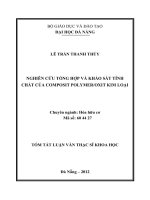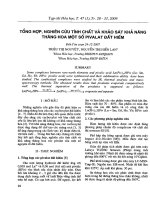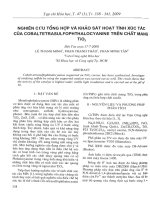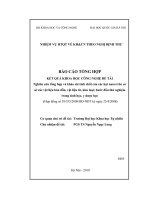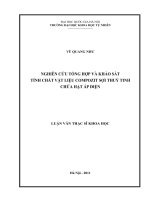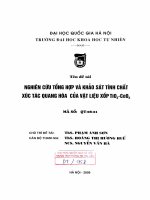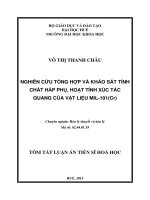Nghiên cứu tổng hợp và khảo sát khả năng diệt khuẩn của oligome trên cơ sở guanidin trong xử lý nước nhiễm khuẩn tt tiếng anh
Bạn đang xem bản rút gọn của tài liệu. Xem và tải ngay bản đầy đủ của tài liệu tại đây (1.68 MB, 27 trang )
MINISTRY OF EDUCATION AND TRAINING
MINISTRY OF DEFENCE
ACADEMY OF MILITARY SCIENCE AND TECHNOLOGY
NGUYEN VIET HUNG
SYNTHESIS AND INVESTIGATE THE ANTISEPTIC ACTIVITY
OF OLIGOMER BASED ON THE GUANIDINE FOR TREATING
THE INFECTED WATER SUPPLY
Major: Organic chemistry
Code: 944 01 14
SUMMARY OF DOCTORAL THESIS IN CHEMISTRY
HA NOI - 2019
The thesis has been completed at:
ACADEMY OF MILITARY SCIENCE AND TECHNOLOGY
Scientific Supervisors:
1. Prof. Dr. Nguyen Viet Bac
2. Associate Prof. Dr. Tran Van Chung
Reviewer 1: Prof. Dr. Vu Thi Thu Ha
Vietnam Institute of Industrial chemistry
Reviewer 2: Associate Prof. Dr. Chu Chien Huu
Academy of Military Science and Technology
Reviewer 3: Associate Prof. Dr. Dong Kim Loan
Vietnam National University, Ha Noi
The thesis was defended at the Doctoral Evaluating Council at Academy level
held at Academy of Military Science and Technology at…....date ……….., 2019.
The thesis can be found at:
- Vietnam National Library
- Library of Academy of Military Science and Technology
1
INTRODUCTION
1. The necessaries
The issue of environmental sanitation has been of particular concern to the
public as it directly relates to human health and environmental ecology. Pollution of
water resources due to the wastewater from factories and domestic effluents containing
pathogenic microorganisms is the main cause of disease outbreaks affecting human
health. Currently, people mainly use traditional disinfectants such as hypochlorite,
chlorine, chloramine B ... However, these disinfectants must be often used in large
quantities, when disinfecting the water producing chlorine compounds so that are
directly harmful to the health of humans and organisms [2], [4].
Therefore, new biocidal products, with the high disinfection effect, low
toxicity, that do not create dangerous by-products in the process of sterilization, easy to
use and friendly with the environment have been used by many domestic and foreign
organizations. There are three types of antimicrobial antigens that are being extensively
studied, including antibacterial peptidomimetic polymers, amphiphilic polymers and
oligomers, and nonionic polymers [51]. Oligome hexamethylene guanidine
hydrochloride (OHMG.HCl) is a cationic polymer being studied as a biocide in medical
and industrial applications, due to the wide range of bactericidal, low-usage and highly
active disinfectant. The research on the synthesis of guanidine-based bactericidal
oligomers has been started. However, there have been no published guidelines on the
method and conditions for the synthesis of bactericidal oligomers as well as the
application of compounds based on guanidine. These are the bases for PhD students to
select and propose thesis topic “Synthesis and investigate the antiseptic activity of
oligomer based on guanidine for treating the infected water supply”.
2. The goal of thesis
+ The synthesized and classification of bactericidal oligomer based on guanidine
to be applied in pratice.
+ Evaluation of the efficiency, bactericidal activity of guanidine oligomer
synthesized in treatment of infected water.
3. The main research
+ Overview of documents on: Contamination of water sources, common
methods and chemicals used in disinfection; Situation of research, application and
methods of synthesis of guanidine based biocide.
+ Researching clarifying issues related to mechanisms, methods and synthesis
conditions of oligomer based on guanidine, in order to obtain high efficiency
OHMG.HCl with appropriate molecular weights for the purpose of treating infected
water.
2
+ The study evaluated the disinfection ability of synthetic oligomers in infected
water treatment.
+ Study on the compare bactericidal effect and environmental friendliness of
synthetic oligome with biocide based on chlorine compounds.
4. Scientific and practical value of the thesis
+ Successfully synthesized and clarified the scientific basis of the reaction
conditions of guanidine-based oligomer synthesis.
+ Results of the study evaluating the disinfection ability of synthetic oligomers
in the treatment of infected water sources, showing efficacy and environmental
friendliness compared with chlorine-based microbicides. The results of the thesis
contribute to the diversification of bioproducts used in the treatment of bacterial
wastewater in Vietnam.
5. Structure of the thesis
The thesis has 124 pages including:
Introduction: 3 pages; Chapter 1. Overview: 33 pages; Chapter 2. Subjects and
methods of research: 13 pages; Chapter 3. Results and discussion: 45 pages; Conclusion:
2 pages; List of scientific works related to thesis: 1 page; References: 13 pages (105
references).
CHAPTER 1: OVERVIEW
1.1. Contaminated wastewater
The sources of biological pollution and bacterial contamination in the water
environment are mainly cause by domestic wastewater, hospital wastewater, biological
wastes and waste…
Current technologies for treating bacterial waste water include: Sequencing
batch reactor (SBR); Membrane Bio Reactor (MBR); Moving Bed Biofilm Reactor
(MBBR); Continuous biological treatment technology uses a variety of microorganisms
(AAO: Anaerobic - Anoxic - Oxic). The main principle of method are biological
wastewater treatment combined with the physical method [11]. [14].
1.2. Disinfection methods for contaminated wastewater
Various methods of disinfection for wastewater include: chemical methods
(using some strong oxidants such as chlorine and its compounds, ozone ...); Physical
methods (using UV rays) and some other methods (thermal sterilization, ultrasound,
silver ion reduction...).
1.3. Polymers and bactericidal oligomers based on guanidine compounds
Oligomer bactericides based on guanidine namely oligo (hexamethylene)
guanidine hydrochloride - OHMG.HCl, IUPAC nomenclature are guanidine
hydrochloride polyhexamethylene (PHMG). Oligo (hexamethylene) guanidine
hydrochloride usually exists in the form of white or yellowish powder; good solubile in
3
water, alcohol, glycol, ether. With the ability to kill bacteria at low levels, not toxic,
odorless; OHMG.HCl has been widely used as a biocide in homes, hospitals, water
purifiers in many countries around the world [41- 42], [54], [104].
- The bactericidal effect of the OHMG.HCl molecule is based on the positive
charge of the guanidine moiety within each monomer. The mechanism of action is: the
adsorption of the positively charged N+ ions of the OHMG.HCl molecule on negative
charge sits on the bacterial cell wall attracts or altering the osmotic pressure that disrup
the cell membrane.
- OHMG.HCl is synthesized from guanidine hydrochloride (GHC) and
hexamethylene diamine (HMDA) in the melting state. This is a condensed reaction,
occurring in the nucleophilic (AN) addition mechanism as shown in Figure 1.1.
Figure 1.1: Straight chain OHMG.HCl synthesis reaction using HMDA
Conclusion of the chapter 1:
Through the overview of technology, methods and materials for synthesis of
disinfectant OHMG.HCl, if performed under conditions of our country, it will be highly
feasible. Therefore, the research and production of OHMG.HCl and its application in
treating waste water are the research objective of the thesis.
CHAPTER 2: SUBJECTS AND METHODS OF RESEARCH
2.1. Research subjects
- Monomers for synthesis of bactericidal oligomers based on guanidine, namely
OHMG.HCl.
- Gram-negative bacteria (-), coliform and E. coli, molds ... to evaluate the
biocidal activity of synthetic oligomer.
- Effected water sources such as domestic wastewater, hospital wastewater,
slaughterhouse wastewater to assess the disinfection efficiency of products.
2.2. Research methods
2.2.1. Chemical, tools and equipments
* Chemical:
Guanidine hydrochloride: white crystals with the formula H2NC(=NH)NH2.HCl,
molecular mass 95.53 g / mol, purity ≥ 99.0% (Merck, Germany); Hexamethylene
diamine: white crystals, water vapor and fume in air, formulated as H2N-(CH2)6-NH2,
molecular mass 116,21 g / mol purity ≥ 99.0% (Merck, Germany); Chloramine B: solid
(C5H5SO2NClNa.3H2O), active chlorine content ≥ 25%, NaOH content ≤ 0.8%
(Bochemie, Czech); Agar, peptone, Lactose, K2HPO4, Na2SO3, alkaline Frucsin; Types
4
of microorganisms: Bacillus subtilis, E.coli, Coliform, mold; Environment of
microorganisms growing: normal, LB broth and Hansen broth; Standard tube NaOH
1N: plastic tube, specific gravity 1,03 g/cm3, pH=14 (H2O, 20 oC), (Merck, Germany);
Standard tube HCl 1N : plastic tube, specific gravity 1,03 g/cm3, pH <1 (H2O, 20 oC),
(Merck, Germany); The water of To Lich river, Duc Giang General Hospital wastewater,
Phung Khoang slaughterhouse wastewater; NaCl solution: phase at 0.2 N; 0.3 N; 0.4 N;
0.5 N; Solvents: Ethanol, Acetone, DMSO, ether ...
* Tools and equipment for organic synthesis
Organic synthesis tools include three-necked flask, reed condenser, gas
absorber, stirrer, heating system, cooling system ...; MSH 20 D/MP4 magnetic stirrer;
Laboratory instruments: measuring cup 500ml; 250m, bottle contains sample ...
* Tools and equipment for analysis
Electronic balance AAA250 - ADAM accuracy 0.0001g; PH Meter HI2215 pH /
ORP Meter - HANNA; Ubbelohde capillary glaucoma.
2.2.2. OHMG.HCl synthesis process
In a 500 mL three-neck flask, there is a
stirrer, thermometer and vacuum system,
NH3 absorption system. Take 20 g (0.172
mol) hexamethylene diamine and 16.44 g
(0.172 mol) guanidine hydrochloride
(HMDA:GHC = 1:1 ratio). Heat and
maintain the reaction at 100 °C for 1 h, then
raise the reaction temperature to range of
120-180 °C and keep the reaction
temperature for 3 to 8 h. The resulte
OHMG.HCl product is a viscous liquid,
Figure 2.1. Reaction equipment system
bright yellow and solidified after cooling.
OHMG.HCl synthesis
The factors that affect the reaction process such as the proportion of reactants,
time and reaction temperature were studied. Efficiency, metabolism of reaction are
determined by NH3 removal from the reaction system. The synthesized oligomers are
dissolved in distilled water and filtered through a Schott vacuum filter at 60 °C for 3 h;
The formed gel is dried to constant weight [19-20], [45].
2.2.3. Methods of analysis, determination of physical and chemical properties
Analytical methods such as infrared spectroscopy (IR); nuclear magnetic
resonance (1H NMR,13C NMR,COSY,HSQC); gel chromatography (GPC); Mass
spectrometry (MS); Thermal analysis method (TGA); Liquid chromatography - mass
spectrometry (LC- MS); Scan electron microscopy (SEM) and Transmission electron
microscopy (TEM) were used.
2.2.4. Methods of evaluation, testing of bactericidal activity
5
2.2.4.1. The solubility of the product
2.2.4.2. Methods of assessment of disinfection ability
+ Disk diffusion
+ Minimum Inhibition Concentration (MIC)
+ The time for killing bacteria by minimum bacteria concentration (MBC)
2.2.5. Investigation of factors affecting the disinfection ability of OHMG.HCl for
contaminated wastewater
The infected water samples are taken according to TCVN 6663-1: 2011,
preserved and stored according to TCVN 6663-3: 2008 and analyzed and determined
before and after treatment according to current Vietnamese standards, applying for
wastewater treatment.
CHAPTER 3: RESULTS AND DISCUSSION
3.1. Research results of syntheszed OHMG.HCl oligomer
3.1.1. Study on the ability to synthesize OHMG.HCl by molten condensation method
3.1.1.1. Investigation of OHMG.HCl synthesis
Table 3.1: Infrared spectral analysis of OHMG.HCl synthesis
Functional group
Peak (cm-1)
GHC
HMDA
OHMG.HCl synthesized
ν (NH)
3401.16
3460.28
3309.79; 3176.76
ν (C=N)
1642.80
1651.49
δ (NH)
1534.95
1561.25
1435.50
ν (C-N)
1009.31
1328.30
1354.94
ν (Cl-Cl)
517.93
676.70
Table 3.1 shows the variation of the characteristic peaks of guanidine
hydrochloride (Fig. 3.1) and hexamethylene diamine (Figure 3.2) to form the
OHMG.HCl product (Figure 3.3). This result demonstrates the conversion of the
reactant in the condensation reaction to form OHMG.HCl.
Figure 3.1: Infrared spectrum of GHC
Figure 3.2: Infrared spectrum of HMDA
6
Figure 3.4: 1H-NMR spectrum
Figure 3.3: Infrared spectrum
of OHMG.HCl synthesized
of OHMG.HCl synthesized
Nuclear Magnetic Resonance Spectrum (1H-NMR) at 125 MHz of OHMG.HCl
synthesized (Figure 3.4) shows: pic 7.49 ppm (1H, J = 7,789 Hz) - corresponding to
group - NH-C (NH) -NH-; peak 3.39 ppm (1H, J = 3,371 Hz) - corresponds to the group
– CH2-NH-; peak 1.81 ppm (2H, J = 1,996 Hz) - corresponds to the group (- CH2-)n,
indicating the formation of OHMG.HCl in the synthesized product, similar to the results
of Martin Albert et al. [70].
The results of this study have shown that OHMG.HCl can be synthesized from
GHC and HMDA by the melting condensation reaction.
3.1.1.2. The dependence of molecular weights on the basic properties of OHMG.HCl
Table 3.2: OHMG.HCl molecular mass was obtained in the study
Sample
1
2
3
4
5
6
7
o
Reaction temperature ( C) 120
130
140
150
160
170
180
average Molecular weight
MW (g/mol)
235
281
359
409
486
526
778
Reaction efficiency (%)
30
39
51
60
75
90
98
Determination of the obtained molecular weight depending on the temperature
shown in Table 3.2 indicates that the OHMG.HCl molecular weight depends on the
reaction temperature. As the temperature rises, the process of oligomerization increases,
the reaction efficiency increased molecular weight.
* Effect of molecular weight to internal viscosity of OHMG.HCl solution
Table 3.3: Relationship of molecular weight to internal viscosity
of OHMG.HCl solution obtained in the study
Sample
1
2
3
4
5
6
7
average Molecular weight 235
281
359
409
486
526
778
MW (g/mol)
Internal viscosity (dl/g)
0.002 0.003 0.004 0.005 0.006 0.009 0.012
7
Average Molecular weight (g/mol)
800
700
600
500
400
300
200
2
4
6
8
Internal viscosity (dl/g.10-3)
10
12
The results showed that the
internal viscosity of OHMG.HCl
solution increased with the increase
of molecular weight. Viscosity
change occurs due to the in
OHMG.HCl molecular size. This
leads to OHMG.HCl having a too
large molecular weight, which in
turn affects the molecular dynamics
and solubility of the oligomer.
Figure 3.5: Relational chart Mw to
internal viscosity of OHMG.HCl solution
* Effect of molecular weight to solubility of OHMG.HCl in various solvents
Table 3.4: Effect of molecular weight to solubility of OHMG.HCl
Solubility (g/100 g solution)
average Molecular
Sample
Ethanol
Acetone
weight MW (g/mol) Distilled water
1
235
190
120
< 0.01
2
409
162
110
< 0.01
3
526
155
102
< 0.01
4
645
158
100
< 0.01
5
968
150
95
< 0.01
The results in Table 3.4 indicate that OHMG.HCl is limited in non-polar
solvents, good soluble in polar solvents. But as the molecular mass increases, the
solubility of the oligome in water and ethanol is significantly reduced. Specifically,
when Mw is below 350 g / mol, the solubility of OHMG.HCl is above 100 g in both
solvents. When Mw is about 500 g / mol, the solubility of OHMG.HCl in water is 150 g,
and in ethanol is less than 75 g. When Mw is close to 800 g / mol, the solubility of
OHMG.HCl is greatly reduced, in water is 125 g, and in ethanol is 51 g. It is necessary
to select the optimal conditions to synthesize products with high water solubility, when
they want to be used as biocides in wastewater disinfection technology.
* Effect of molecular weight to E. coli disinfection ability of OHMG.HCl
Table 3.5: Effect of molecular weight on E. coli's ability to kill OHMG.HCl
(Antibacterial ring diameter - mm)
OHMG.HCl molecular weight
Bacteria
Blank
experiment
235
409
526
645
968
sample
E. Coli
0 mm
2.6 mm 2.8 mm 3.5 mm 3.0 mm 2.8 mm
Table 3.5 shows that the high efficiency of E. coli corresponds to the molecular
weight of OHMG.HCl reaches from 500 g/mol or more.
8
3.1.2. Research and survey the factors affecting the synthesis of OHMG.HCl at scale
of 150 g /batch
3.1.2.1. Effect of reaction temperature
Carry out the reaction according to the conditions: molar ratio [HMDA]: [GHC]
= 1: 1 (Specifically, weighing 100 g HMDA and 82.2 g GHC respectively in the reaction
system); Reaction time = 5 hours. Surveying the effect of reaction temperature on the
average molecular weight of OHMG.HCl in the range 120 °C - 180 °C. The results are
shown in Table 3.6 and Figure 3.6 graph.
Table 3.6: Effect of reaction temperature to molecular weight
Sample
1
2
3
4
5
6
7
o
Reaction temperature ( C) 120
130
140
150
160
170
180
average Molecular weight
235
281
359
409
486
526
778
MW (g/mol)
Reaction efficiency (%)
30
39
51
60
75
90
98
The results showed that the
average
molecular
weight
of
100
800
OHMG.HCl formed exibites a
significant dependence on the
80
reaction temperature. Previous studies
600
have shown [46] that the maximum
60
bactericidal effect corresponds to the
400
average
molecular
weight
of
OHMG.HCl from 500 to 650 g/mol.
40
On this basis, the optimum
200
temperature
for
OHMG.HCl
20
120
130
140
150
160
170
180
synthesis is 170 °C, where
Reaction temperature, ( C)
OHMG.HCl produceds gives Mw =
Figure 3.6: Effect chart of reaction temperature 526 g/mol.
to Mw of OHMG.HCl
Reaction efficiency (%)
Average Molecular weight MW (g/mol)
Average Molecular weight
Reaction efficiency
o
3.1.2.2. Effect of reaction time
Table 3.7: Effect of reaction time to averagre molecular weight of OHMG.HCl
Reaction time (h)
3
4
5
6
7
8
averagre Molecular weight
408
485
526
680
784
973
MW (g/mol)
9
Average Molecular weight
Average Molecular weight (g/mol)
1000
800
600
400
2
4
6
8
Reaction time, hours
The results show that the
average molecular weight of
OHMG.HCl is dependent on the
reaction time and increasing with
time of reaction. Previous research
results [46], [70], [101] show that
the maximum water-bactericidal
efficiency of oligomers is the
highest value with an average
molecular weight of 500 - 650
g/mol. From the results of the
survey, the optimum time for
OHMG.HCl synthesis is 5 hours.
Figure 3.7: Effect chart of reaction time
to Mw of OHMG.HCl
3.1.2.3. Effect of content of reactants
Bảng 3.8: Effect of content of reactants to averagre molecular weight of OHMG.HCl
[HMDA]:[GHC] ratio
1 :1
1:1.05 1:1.1
1:1.15
1:1.2
1:1.3
averagre Molecular weight
442
498
526
724
864
1013
MW (g/mol)
1100
Average Molecular weight (g/mol)
1000
900
800
700
600
500
400
1.00
1.05
1.10
1.15
1.20
Ratio [GHC]:[HDMA]
1.25
1.30
The results showed that the
average OHMG.HCl molecular weight
increased with the use of excess
guanidin hydrochloride. However, as
the maximum bactericidal efficiency
was determined corresponding the
average
molecular
weight
of
OHMG.HCl from 500 to 650 g/mol
(due to the solubility of the product in
water). So that the optimum ratio of
reactants is selected as [HMDA]:
[GHC] = 1: 1.1.
Figure 3.8: Effect chart of [HMDA]: [GHC]
ratio to Mw of OHMG.HCl
3.2. Results of analysis of the structure and properties of OHMG.HCl
3.2.1. Physical and chemical analysis of OHMG.HCl
3.2.1.1. Results of infrared spectrum
Table 3.9 shows the correlation between infrared absorption peaks and
functional groups in OHMG.HCl synthesized corresponding to the infrared spectrum of
products imported from the Russian Federation.
10
Table 3.9: Peak comparison results of OHMG.HCl infrared spectrum
Functional
Peak (cm-1 )
group
OHMG.HCl synthesized
OHMG.HCl
from the Russian Federation
ν (NH)
3396.29 ; 3218.73
3365 ; 3230
ν (C=N)
1648.66
1650
δ (NH)
1456.52
1520
ν (C-N)
1097.31
1120
ν (Cl-Cl)
520.90
520
Figure 3.10: Infrared spectrum of
Figure 3.9: Infrared spectrum of
OHMG.HCl synthesized
OHMG.HCl from the Russian Federation
3.2.1.2. Results of 1H-NMR spectrum and 13C-NMR spectrum
Figure 3.11: 1H-NMR spectrum
Figure 3.12: 13C-NMR spectrum
of OHMG.HCl synthesized
of OHMG.HCl synthesized
From the results of the analysis for the expected formula of the product as
follows:
11
Figure 3.13: Structural formula (expected) of OHMG.HCl synthesized
Based on the above formula, the result of complete reconciliation of the
resonant signals in the 13C-NMR spectrum of OHMG.HCl from Figure 3.14 is shown in
Table 3.10 as follows.
Table 3.10: The results of the resonance coordinate signal in the 13C-NMR spectrum
of OHMG.HCl
Location of
I
II’
II
III’
III
IV
IV’
carbon atoms
Chemical shift
25.46 28.24 39.78 40.53 40.71 155.81 157.03
(ppm)
The results showed that the lack of resonance characteristic for the HMDA and
GHC headers respectively at 27.23 and 160.22 ppm confirmed that they had been lost.
The resonant signals in the 13CNMR spectrum are grafted onto the C-atoms of the
hexamethylene base (I, II, and III) and for these radicals when it is at the end of the
chain (II 'and III') and indicate them in the form straight links. Peak resonances belong
to the C IV 'atoms of guanidine atoms once that is also close to 156-159 ppm along with
the main resonance of C IV.
Through the 1HNMR spectrum and 13CNMR spectrum spectra, the presence of
the major derivative in the product was the linear oligo hexamethylene guanidine
hydrochloride.
3.2.1.3. Results of mass spectrum
Figure 3.14: Mass spectrum
of OHMG.HCl synthesized
Figure 3.15: Mass spectrum of synthetic
PHMG.HCl according to Dafu Wei
and his associates [44]
12
The mass spectra of OHMG.HCl (Fig. 3.16), compared with the results of Dafu
Wei and his associates (Figure 3.17) [44], show that:
+ Comes with the pic 159.1; 300.2; 442.4; 582.5; 723.6; 864.8 characterizes the
mass spectrum of OHMG.HCl having a linear structure (type A – [1+(141)n+16+1]).
+ Comes with the pic 258.2; 399.3; 540.5; 681.6; 822.7; 963.9 characterizes the
mass spectrum of OHMG.HCl having a linear structure (type B – [100+(141)n+16+1]).
Thus, compared with the results of Dafu Wei and his associates, It can be
confirmed that OHMG.HCl synthesis is mainly in the form of linear structures of types
A and B.
3.2.1.4. Results of COSY spectrum and HSQC spectrum
The COSY spectrum, the HSQC spectrum of the synthetic OHMG.HCl are
shown in Figure 3.16, Figure 3.17.
Figure 3.17: HSQC spectrum
Figure 3.16: COSY spectrum
of OHMG.HCl synthesized
of OHMG.HCl synthesized
From Figure 3.17, it is shown that
According to this two-dimensional
resonance spectrum, OHMG.HCl has three there is a horizontal bond of N-H of the
carbon chain R- CH2-CH2CH2-NH2) hydrogen outside of the C-H bond in the
groups and one (-CH2-CH2CH2-NH-CNH- chain group (R- CH2- CH3CH2-NH2) and
NH2) a straight line, one group (R-CH2- the group (- CH2- CH2CH2-NH-CNHCH3CH2-NH2) is not the same line with the NH2); H-Cl bonded via NH.HCl coordinate
other four. Shows the degree of dispersion, linkage in the OHMG.HCl molecule
branching in the OHMG.HCl molecule.
synthesized.
From the above results, molecular formula can be constructed as shown in Fig.3.18:
13
Figure 3.18: Structural formula of OHMG.HCl synthesized
3.2.1.5. Determination of average molecular weight by gel chromatography
Figure 3.19: Gel chromatography schematic
of OHMG.HCl synthesized
3.2.1.6. Results of thermal analysis
On the GPC schematic, a
single peak peak is obtained, which
shows that the product synthesizes
a uniform molecular weight.
OHMG.HCl has a mean molecular
weight Mw: 521 g/mol, molecular
weight Mn: 487. Dispersion
Mw/Mn = 1.07. This result is
consistent with the results reported
in the previous section.
On the diagram (Figure 3.20), the DTG
line appears at 3 points for sample change at
120; 377.5 and 485.7 oC due to dehydration
and thermal oxidation decomposition in
OHMG.HCl. Specifically, at 120 oC due to
dehydration (OHMG.HCl has high desiccant
properties) and 377.5 oC due to the
decomposition of the biguanite group and at
485.7 oC due to the decomposition of carbon
bonds in the oligomer. The remaining 9.89%
is ash, resulting in high temperature
polymerization. The TGA results also
indicate that OHMG.HCl is less oxidized
under the influence of temperature
o
Figure 3.20: Thermal analysis schematic (decomposition at 330 C).
of OHMG.HCl synthesized
14
3.2.2. Results of the bactericidal activity test of OHMG.HCl
3.2.2.1. Result of diffusion method in the lithosphere
The test results show that
OHMG.HCl is capable of
killing microorganisms with
different species including
gram (+), gram (-) and yeast.
With this method can partly
confirm the disinfection range
of OHMG.HCl synthesized
products are relatively broad.
Figure 3.21: Antibacterial ring of the OHMG.HCl for
bacterial types(B.subtilis; E.coli; S. Cerevisiae)
Table 3.11: Results of antimicrobial testing of OHMG.HCl
(Antibacterial ring diameter - mm)
OHMG.HCl concentration (ppm)
Types of
Blank sample
5
10
50
bacteria
B. subtilis
0
0
1.5
4.5
E. coli
0
2
3
7
S. cerevisiae
0
4
6
8
100
9
11
15
3.2.2.2. Result of the minimum inhibitory concentration index (MIC)
Table 3.12: Development of E. coli
by OHMC.HCl concentration
Number
OHMG.HCl
concentration
Result
(ppm)
1
100
2
50
3
10
4
5
5
3
+
6
1
+
Figure 3.22: Test the minimum
antimicrobial concentration of the
OHMG.HCl product
Table 3.12 shows that, with concentration > 5 ppm, there is no growth of the E.
coli strain in the sample. Inferior, the MIC index of OHMG.HCl is 5 ppm. It has been
shown that OHMG.HCl has a very small concentration of bactericidal activity.
15
3.2.2.3. Result of the time for killing bacteria by minimum bacteria concentration (MBC)
Table 3.13: Development of E. coli
by MBC method
Number
Time
OHMG.HCl
(min)
(5 ppm)
1
1
+
2
4
+
3
6
+
4
8
+
5
10
+
6
11
+
8
12
9
13
Figure 3.23: Photo of bactericidal time
10
14
11
15
test of OHMG.HCl product
From the results of Table 3.13, the optimum bactericidal time was 12 minutes. It
showed that the bactericidal activity of OHMG.HCl was rather fast, with low
concentration, indicating that the obtained product had good bactericidal activity.
Accordingly, based on the results of the study, the thesis proposes the process of
synthesis OHMG.HCl used as a disinfectant in the treatment of waste water as follows:
* OHMG.HCl synthesis process
OHMG.HCl is synthesized in reactors equipped with stirrers, thermometers,
vacuum systems (NH3 removal) and NH3 adsorption systems. Performing the melting
reaction according to the following regimes:
- The ratio of substances used for the reaction: [HMDA]: [GHC] = 1: 1.1 mol.
- Temperature, time: 1 h at 100 oC, then raise the temperature to 170 oC and
stirring continuously for 5 h to stop the reaction.
Carry out the purification, drying in vacuum at 60 °C to constant volume,
obtaining the OHMG.HCl product having the basic technical and physical properties as
shown in Table 1.1 below.
Table 3.14: Physical and chemical properties of OHMG.HCl synthesized.
Number
Parameter
Level
1
Appearance
Solid powder, light color, odorless
2
Molecular weigh (g/mol)
521
3
pH (solution 1%)
6,8 - 7
4
Solubility (g/100g solvent)
Water (145), ethanol (100),
methanol (123), acetone (0,01)
5
Bactericidal activity
- MIC (ppm)
5
- MBC (min)
12
3.3. Evaluation of the bactericidal activity of OHMG.HCl synthesized in bacterial
water treatment
3.3.1. Results of the To Lich river wastewater treatment
16
3.3.1.1. Composition and characteristics of To Lich river wastewater
Table 3.15: Basic properties of To Lich river wastewater
QCVN14-2008
Number
Parameter
Unit
Result
(column B)
1
pH
7-8
5-9
2
SS
mg/l
103
100
o
3
BOD5 (at 20 C)
mg/l
72
50
4
COD
mg/l
93
5
TDS
mg/l
320
1000
6
NO3 (according to N)
mg/l
66.9
50
37
PO4 (according to P)
mg/l
26.4
10
3
8
Total Coliform
MPN/100ml
90.10
5.103
The analysis results in Table 3.15 show that most of the characteristics of
pollution such as BOD5; NO3-; PO43- are higher than domestic wastewater according to
QCVN 14: 2008 / BTNMT. In particular, the total coliform content is 18 times higher
than that of standard B for the maximum allowable values of domestic effluent
parameters (QCVN 14: 2008 / BTNMT).
3.3.1.2. Disinfection ability of OHMG.HCl for To Lich river wastewater
* Effect of OHMG.HCl concentration to the effectiveness of disinfection
Carry out the test in accordance with section 2.2.5 with the following
conditions: stirring rate 250 rpm, OHMG.HCl at different concentrations and time to
bactericidal efficiency.
Table 3.16: Effect of OHMG.HCl content to the effectiveness of disinfection
Time, min
OHMG.HCl
Parameter
concentration
0
5
10
30
45
MPN/100ml
11860 11860 11860 11860 11860
Sample input
η (%)
0
0
0
0
0
MPN/100ml
11860 8100
5600
5400
4800
η (%)
0
31.7
52.8
54.5
59.5
MPN/100ml
11860 6400
6240
5340
4200
5ppm
η (%)
0
32.5
64.2
66.1
66.3
MPN/100ml
11860 6000
3800
2600
2400
10ppm
η (%)
0
49.4
68.0
78.1
79.7
Based on the analysis of Coliforom in the water after treatment showed that the
ability of disinfection of OHMG.HCl is effective at 1 ppm. At 10 ppm, bactericidal
efficiency increased with time (49.6% after 5 minutes and reached 79.7% efficiency
after 45 minutes).
1ppm
17
* Effect of stirring speed and time on the effectiveness of disinfection
Table 3.17: Effects of stirring speed and time on the effectiveness of disinfection
Stirring
Time, min
speed
Parameter
(r/min)
0
5
10
30
45
250 rpm
150 rpm
80 rpm
MPN/100ml
24000
10000
3200
2240
1800
η (%)
0
58.3
86.7
90.6
92.5
MPN/100ml
24000
13500
8200
6800
5620
η (%)
0
43.8
65.8
71.7
76.6
MPN/100ml
24000
15000
10800
8360
7500
η (%)
0
37.5
55
65.2
68.8
The results showed that, with agitation speed v = 250 rpm, the optimum time for
bactericidal E. coli was 92.5%, 45 minutes (after 10 minutes of treatment) 86.7% is
QCVN-2008, column B). High stirring speed, disinfectants quickly and uniformly
dissolved in the waste water to facilitate the biocide kill bacteria faster.
* Effects of suspended solids to the effectiveness of disinfection
Apply the method described in Section 2.2.5 under conditions: OHMG.HCl 5
ppm, stirring rate 250 rpm.
Table 3.18: Effects of To Lich river’ suspended solids to the effectiveness of disinfection
Sample
Time, min
Parameter
0
2
5
10
30
MPN/100ml
11000
6400
5800
4900
4200
η (%)
0
41.8
47.3
55.5
61.8
MPN/100ml
10000
100
40
20
20
η (%)
0
99.0
99.6
99.8
99.8
Unfiltered
Filtered
The results in Table 3.18 show that the disinfection efficiency of OHMG.HCl is
limited to the suspended solids effluent (62-65% compared to 99.8% when wastewater is
not suspended solids due to the reduced OHMG.HCl content (absorbed by solid deposits
suspended in charged form), the bactericidal activity decreases.
18
* Effect of pH on the disinfection ability of OHMG.HCl
Table 3.19: Effect of pH on the disinfection ability of OHMG.HCl
Number
Results after treatmenting by OHMG.HCl
Sample
Coliform
E .coli
(MPN/100ml)
(MPN/100ml)
1
2
3
4
5
6
Sample input
17500
400
pH = 5
3100
145
pH = 6
3000
85
pH = 7
2500
75
pH = 8
2650
100
pH = 9
2730
80
Test method
TCVN 6187- 2:2009
3.3.2. Results of Duc Giang General Hospital wastewater treatment
3.3.2.1. Composition and characteristics of Duc Giang General Hospital wastewater
Table 3.20: Properties of Duc Giang General Hospital wastewater
QCVN 28:2010/
Num
Parameter
Unit
Result
BTNMT (Column B)
1
pH
9
6,5 - 8,5
o
2
BOD5 (20 C)
mg/l
126
50
3
COD
mg/l
241
100
4
Suspended solids (SS)
mg/l
130
100
5
NO3 (according to N)
mg/l
25,5
10
36
PO4 (according to P)
mg/l
15
10
Oil and grease
7
mg/l
60
20
3
8
Total coliform
MPN/100ml 95.10
5.103
3.3.2.2. Disinfection ability of OHMG.HCl for Duc Giang General Hospital wastewater
* Effect of OHMG.HCl concentration to the effectiveness of disinfection
Table 3.21: Effect of OHMG.HCl concentration to the effectiveness of disinfection
Time, min
OHMG.HCl
Parameter
concentration
0
5
10
20
30
MPN/100ml
12565 12565 12565 12565 12565
Sample input
(%)
0
0
0
0
0
MPN/100ml
12565
8510
7440
5840 5210
1ppm
(%)
0
32.2
40.8
53.5
58.5
MPN/100ml
12565
7125
6240
4680 4150
5ppm
(%)
0
43.3
50.3
62.7
66.9
MPN/100ml
12565
6210
4100
3120 2650
10ppm
(%)
0
50.5
67.3
75.2
78.9
19
* Effects of suspended solids to bactericidal time
Table 3.22: Effects of suspended solids of Duc Giang General Hospital wastewater
to bactericidal time
Time, min
Sample
Parameter
0
5
10
20
30
MPN/100ml 18650
8550
7360
6370
5430
Unfiltered
(%)
0
54.1
60.5
65.8
70.1
MPN/100ml 11850
4760
2560
1750
970
Filtered
(%)
0
59.8
78.4
85.2
91.8
* Effect of pH on the disinfection ability of OHMG.HCl
Table 3.23: Effect of pH on the disinfection ability of OHMG.HCl
Results after treatmenting by OHMG.HCl
Number
Coliform
E .coli
Sample
(MPN/100ml)
(MPN/100ml)
1
Sample input
12560
415
2
pH = 6.5
3560
185
3
pH = 7
3150
126
4
pH = 7.5
2650
80
5
pH = 8
2600
90
6
pH= 8.5
2670
85
Test method
TCVN 6187- 2:2009
3.3.3. Results of the slaughterhouse wastewater treatment at Phung Khoang, Ha noi
Table 3.24: Basic properties of the Phung Khoang’ slaughterhouse waste water
Num
Parameter
1
2
3
4
5
6
7
8
Temper, oC
pH
Smell
Color, Co-Pt at pH=7
BOD5 (20oC), mg/l
COD, mg/l
Suspended solids (SS), mg/l
Total Nitrogen (NO3-), mg/l
Total Phosphorus (PO43-),
mg/l
Total Coliform, MPN/100ml
9
10
Content
of waste water
Value
medium
26.5 – 33.5
6.5 – 8.0
Hôi tanh
140 - 160
935 - 1165
2340 - 3100
484 - 515
154 - 165
30.0
7.3
Khó chịu
150
1050
2720
499,5
159,5
QCVN 0125:2010/BNNPTNT
(Level B)
40
5.5 – 9.0
Không khó chịu
70
50
100
100
30
16 - 22
19
6
113.103 - 125.103
119.103
5.103
20
* Result of settling and filtering process with PAC
Table 3.25: Basic parameter of slaughterhouse waste water treated with PAC
QCVN 01Value
Num
Parameter
25:2010/BNNPTNT
(Level B)
o
1
Nhiệt độ, C
30.0
40
2
pH
5.8
5.5 – 9.0
3
Smell
Light smell
Not hard to smell
4
Color, Co-Pt at pH=7
100
70
o
5
BOD5 (20 C), mg/l
500
50
6
COD, mg/l
1250
100
7
Suspended solids (SS), mg/l
120
100
8
Total Nitrogen (NO3 ), mg/l
105
30
3-)
9
Total Phosphorus (PO4 , mg/l
10
6
3
10
Total Coliform, MPN/100ml
33.10
5.103
* Effects of OHMG.HCl concentration on the bactericidal effect
Table 3.26: Effects of OHMG.HCl concentration on the bactericidal effect
OHMG.HCl
Time, min
Total
Concentration
coliform
0
5
10
20
30
ppm
MPN/ml
33000
33000
33000
33000 33000
Sample of
wastewater input
(%)
0
0
0
0
0
MPN/ml
33000
24850
20155
15650 10360
5ppm
(%)
0
24.7
38.9
52.5
68.6
MPN/ml
33000
19425
14745
10430
7835
15ppm
(%)
0
41.1
55.3
68.4
76.2
MPN/ml
33000
13160
9825
5610
3795
25ppm
(%)
0
60.1
70.2
83.0
88.5
* Effect of pH on the disinfection ability of OHMG.HCl
Table 3.27: Effect of pH on the disinfection ability of OHMG.HCl
pH
Chỉ tiêu
5.8
6.5
7
7.5
8.0
8.5
9.0
(input)
Total
coliform
33000
3915
4080
4135
4195 4385
4450
(MPN/ml)
(%)
0
88.1
87.6
87.4
87.2
86.7
86.5
3.3.4. The results of the evaluation and comparison of the disinfection efficiency of
OHMG.HCl and chloramine B
21
3.3.4.1. Results of MIC index
Table 3.28: Results of the MIC index of chloramine B and OHMG.HCl
Concentration
Value
Note
Num
(ppm)
OHMG.HCl Chloramine B
(-): no growth
1
100
of bacteria.
2
50
3
10
+
(+): there is
4
5
+
the development
5
3
+
+
of bacteria
6
1
+
+
The results of determining MIC are given in Table 3.28. This is shown that, for
the concentrations of OHMG.HCl > 5 ppm there is no growth of the E. coli strain in,
while for chloramine B is 50 ppm.
3.3.4.2. Results of the time for killing bacteria by MBC index
Table 3.29: Results of the MBC index of chloramine B and OHMG.HCl
MBC value
Time
Number (minute)
Note
OHMG.HCl
Chloramine B
(5 ppm)
(50 ppm)
1
1
+
+
2
2
+
+
(-): no growth
3
4
+
+
of bacteria.
4
6
+
+
5
8
+
+
6
10
+
+
(+): there is
7
11
+
the development
8
12
9
13
of bacteria
10
14
11
15
Table 3.29 shows that the MBC index of OHMG.HCl was 12 minutes and that
of Chloramine B was 11 minutes.
3.3.4.3. Evaluation results of residue after the disinfection by SEM, TEM image
(a): Control
sample
(b): using
Chloramine B
(c): using
OHMG.HCl
Figure 3.24: SEM image of E.coli residue
after the disinfection
It was showed that:
compared with the control
sample (Fig. 3.24a), the
residue of E.coli was very
small and smaller in size
when using OHMG.HCl
for disinfection (Figure
3.24c). In Fig. 3.24b, the
residue of E. coli is very
much and the size is
almost constant.
22
(c)
(a)
(b)
Figure 3.25: TEM image of the E. coli sample
using OHMG.HCl concentration 5ppm
While the TEM image
shown in Fig. 3.25, the E.coli
sample used OHMG.HCl at
5ppm, indicating that the
bactericidal
action
of
OHMG.HCl is the adsorption of
negative charges on the cell wall.
Bacteria attract N+ ions of the
guanidio
groups
in
the
OHMG.HCl molecule.
On the surface of the bacterial cell, OHMG. HCl forms a molecular grid that
inhibits the cell membrane proteins that change the osmotic pressure and cell stability
(Figure 3.25a). Next, OHMG.HCl diffuses across the cell membrane and attaches to the
cytoplasmic membrane forming a complex with the cell membrane (Figure 3.25b). The
structure of the membrane is broken down, the cytoplasmic components are released
into the environment and dead cells (Figure 3.25c).
3.3.4.4. Results of liquid chromatography mass spectrometry of wastewater samples
using disinfection using OHMG.HCl and chloramine B
The results of liquid chromatography of the two samples showed that for the
bactericidal agent OHMG.HCl no retention time was observed for the extra compounds
such as in the prototype with chloramine B (with retention time 0.84 min and 0.85 min)
Figure 3.26: Liquid chromatography of test sample using OHMG.HCl and chloramine B
23
Figure 3.27: MS spectrum of test sample using chloramine B
With the MS spectrum, the two retention times at 0.84 and 0.85 minutes exhibit the
corresponding values of m /z of 162.97 and 128.10 respectively for corresponding two
fragments as CHCl3COO- and CHCl2COO-. As compared to chloramine B, OHMG.HCl
is a high-toxic, non-toxic, non-toxic, non-hazardous by-products, easy to use,
environmentally friendly. Particularly when the use of bactericides is chloramine B, the
presence of by-products is haloacetic acid, while the use of bactericidal agents
OHMG.HCl does not show the presence of these agents. The results of the study
compared the effectiveness of OHMG.HCl with chloramine B, suggesting that the
synthetic OHMG.HCl product is highly effective in killing bacteria and does not
produce harmful byproducts. to the environment...
CONCLUSION
* The results of the thesis have been achieved:
1. The oligo hexamethylene guanidine hydrochloride have been synthesized
with the optimal conditions of molten condensation reaction between
hexamethylendiamine and guanidin hydrochloride from the source of our country’s raw
available materials at the laboratory scale.
2. Results of structure and properties analysis by modern instrumental analysis
methods (IR, 1H-NMR, 13C-NMR, MS, COSY, GPC...), have identified OHMG.HCl
straight branched, molecular weight is 521 g / mol.
3. The results of the bactericidal activity of synthesized OHMG.HCl for some
typical bacteria, showed that the product has a wide range of bactericidal and high
disinfection efficiency. Especially for E. coli (MIC index is 5ppm ; The time for killing
bacteria by minimum bacteria concentration is 12 minutes).

